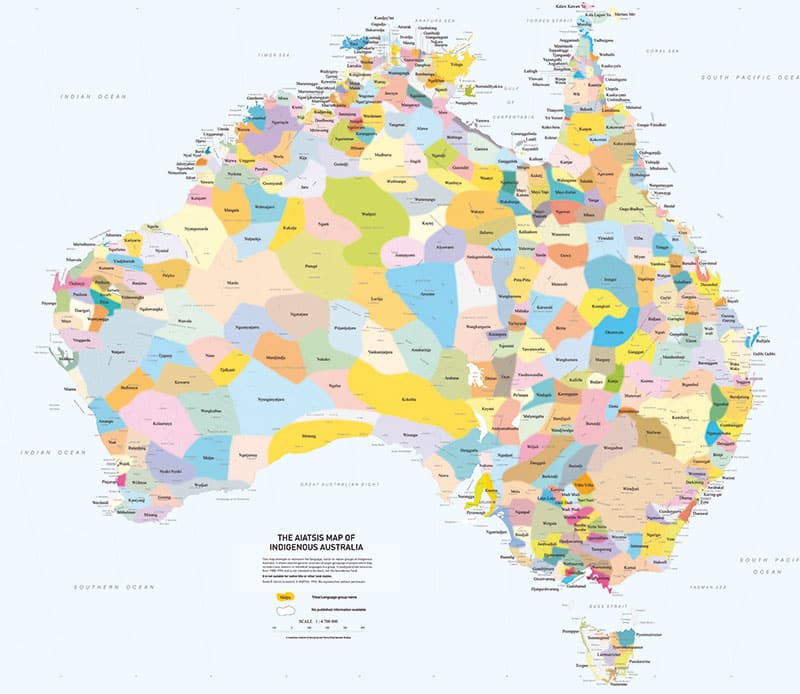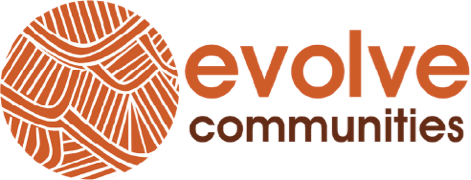Aboriginal people in Australia are not a single homogenous group who speak the same language. When people find out just how many tribes or nations there are, most are amazed to discover the diversity of Aboriginal and Torres Strait Islander Culture. The Indigenous Map of Australia published by AIATSIS (Australian Institute of Aboriginal and Torres Strait Islander Studies) shows there are up to 250 or so Indigenous nations, each having their own language, their own names, and ‘country’ or tribal lands. When viewing the map for the first time, many people draw comparisons with Europe and say they were unaware of just how many different countries or traditional lands they had passed through on their travels throughout Australia. With so many different groups of Indigenous people in Australia, it is important to understand the diversity of Indigenous peoples.
The term ‘Aboriginal’ is not an Indigenous one. It is a colonial term taken from Latin, which means ‘original inhabitant’. Technically speaking, Aboriginal is the adjective whereas Aborigine is the noun. Most Aboriginal people choose to use the adjective rather than the outdated and old–fashioned term Aborigine. Of course, most prefer their Indigenous names such as Bardi or Bundjalung or pan-Aboriginal names that describe groups identifying with a larger geographical area like Koori for the south-east coast of Australia, Nunga for Aboriginal people living in South Australia, Torres Strait Islanders from the Torres Strait Islands, or Murri for Indigenous people in Queensland. Pan-Aboriginality asserts a separate national or regional identity not based on traditional ties to land but through association. It came about as a direct result of colonisation where Aboriginal people were forcibly removed from their families and placed on reserves and missions across Australia. In the process, many Indigenous people lost their language and tribal identity. To assert a distinct Indigenous identity separate from their colonisers, people took on pan-Aboriginal terms like Koori, Nunga, and Murri. I use the terms Aboriginal and Indigenous interchangeably along with specific Indigenous names, but if in doubt, just follow the adage “When in Rome….” and seek guidance from the local community.
What Are the Key Aspects and Diversity of Aboriginal Culture?
Aboriginal people have unique views of the world which differ from those of mainstream groups. Family, land, law, and language are four critical aspects of Aboriginal culture, and Aboriginal families are linked to land via kinship systems. The interconnection to land comes with specific responsibilities and roles outlined in traditional Aboriginal law and observed via ceremonies–so, the five key aspects create a way of living in a distinctly Indigenous world.
No matter where they live, Aboriginal people maintain their cultural identity and make it part of day to day life. As a result, there is an extensive diversity of languages, cultures, ways of life, and kinship structures among Indigenous people across Australia. Likewise, Aboriginal and Torres Strait Islander people have diverse cultures; Aboriginal people also have various tribal groups, family structures, and languages.
Aboriginal Diversity In Language
Even though some nations spoke up to five or six surrounding languages, there wasn’t a single, mother tongue spoken across Australia. The only languages these Indigenous nations share today is either English (introduced during Australia’s colonial history) or an Aboriginal Kriol known as ‘Aboriginal English’. While some individual words are specific to Indigenous nation, there are many other common terms that are understood across Australia such as ‘Dreamtime’, ‘Dreamings’, and ‘Songlines’. Although the Aboriginal languages have complex diversity, they are similar in grammatical construct, pronunciation, sound, and syntax. In other words, the arrangement of words and phrases in sentences follows the same structure across Indigenous languages. Where Dreamtime stories are retold and re-enacted in an Indigenous language, unless fully interpreted, the wisdom contained within remain ‘hidden’ and localised. Language aside, knowledge is not freely available in Aboriginal culture as it is in western society. There are all sorts of restrictions based on age, clan membership, and gender. For example, there are some Aboriginal languages that are only spoken by women and not men, and vice versa. There are also ‘inside’ and ‘outside’ Indigenous languages that pertain to spiritual secrecy.
But while there is great diversity in the expression of Aboriginal cultures, languages, and spirituality, there are some underlying commonalities by way of concepts, principles, and themes that we can identify as relating to Dreamtime, spiritual practices, education systems, gender division, and other cultural elements among Aboriginal groups.
As you do your own research and work to understand the diversity in Indigenous groups, you will learn just how diverse and culturally rich the groups of Aboriginal people are.
Why Is it Important to Have an Awareness of the Diversity of Aboriginal Cultures?
It’s crucial when interacting with or discussing Aboriginal and Torres Strait Islander cultures to be aware of the customs and traditions of Indigenous communities. Being aware of the Aboriginal culture and other Indigenous cultures in Australia shows respect for the cultures you’re working with, which can help you build stronger relationships with Indigenous people, boost your overall cultural understanding, be more efficient in your discussions, and develop greater empathy.
Learning about Aboriginal history and culture also allows people to respect the diversity of Indigenous cultures–Australians should be able to understand and appreciate cultural differences between Indigenous and non-Indigenous cultures. This education and knowledge will provide them with a well-rounded and rich knowledge of Australia’s history and foster a closing of the gap between non-Indigenous and Indigenous Australians in terms of health, opportunity, equality, and well-being. We can all be students of cultural awareness. Learning about Aboriginal culture and fostering a community of inclusion can occur not only inside schools and with formal teachers, but also in our communities and work environments.
What Is the Difference Between Aboriginal and Indigenous?
Indigenous and Aboriginal people are the original inhabitants of a specific geographic location, and have a rich cultural and linguistic historical background; they are also often protected by national and international laws. Native, original, Aboriginal, and Indigenous are some terms used to refer to these specific groups of people.
Curious to learn more about Aboriginal and Torres Strait Islander People?

Photo Credit: David R. Horton © 1996
© Evolve Communities, 2020, All rights reserved

4 Comments. Leave new
It Is a great information about Aboriginal culture and their connection of the Land.
Great information
Hello I’m Janet Richards
My dad had very dark skin and he side of the family Richards Bells, price have Aboriginal in our family
Who can I send all the information to .
Great information regarding the culture of this important people